Tuesday through Sunday from 12:00 until 21:00
Closed Monday
Admission is Free

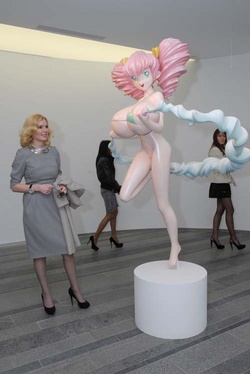
Exhibition view of Takashi Murakami: 'Hiropon', 1997 © by the artist; courtesy PinchukArtCentre; Photo by Markus Tretter
What do you have to say about Sexuality and Transcendence?’ asked Eckhard Schneider, the director of Pinchuk Art Centre, 19 International renowned artists. The result is a show of 150 works on more than 4 floors here in Kiev, Ukraine
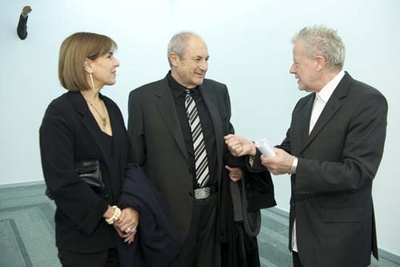
PAC director Eckhard Schneider in conversation with Lietta and Dakis Joannou; Photographs provided by the PinchukArtCentre. 2010 © artist. Photographed by Sergei Illin
The literal meaning of ‘Transcendence’ derives from the Latin expression ‘transcendere’ and means going beyond something. The Indian tantra guru Osho used sexuality as a kind of meditation to elevate his followers to higher spiritual levels. So, I was quite curious to which kind of enlightenment the artists would lead me to.
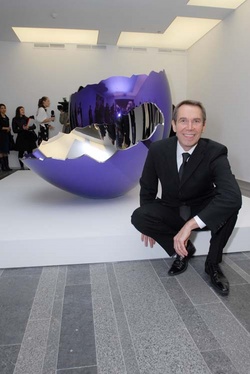
Jeff Koons in front of his sculpture 'Cracked Egg' 1994-2006; Photographs provided by the PinchukArtCentre. 2010 © artist. Photographed by Sergei Illin
The ‘guru’ in this show is Jeff Koons. He is one of the most collected artists in the Pinchuk collection and he has certainly something to say about sexuality and art:
In the late 1980s, Mr. Koons decided to cast himself as porn movie star. He merged Kitsch and sex to create art from porn. At that time, this was revolutionary.
Later, in his ‘Celebration’ series, he focused on objects with super-perfect high-gloss surfaces. I liked the ‘Cracked Egg’ sculpture in the show. I had the impression many guests of the opening were also into this kind of surfaces. Besides the usual glitterati, Pinchuk Art Centre manages to attract an impressive number of real art world VIPs, like Lietta and Dakis Jouannou.
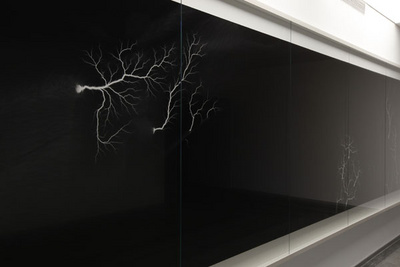
Detail of Hiroshi Sugimoto's 'Lightning Field' of 2009; © by the artist; Courtesy PinchukArtCentre; Photo by Markus Tretter
Japanese artist Hiroshi Sugimoto took the enlightenment literally: He contributed large-scale photo works. They were all black like a sky in the night with scattered white flashes. The title ‘Lightning Fields’ refers to the famous installation in New Mexico by Walter de Maria. I like the calm and meditative way Mr. Sugimoto is approaching the show's issue.
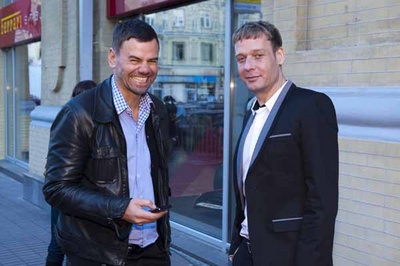
The artists Ingar Dragset (left) and Michael Elmgreen (right); Photographs provided by the PinchukArtCentre. 2010 © Photographed by Sergei Illin
'Sexual coding is to be found in much of the everyday design that surrounds us. Maybe not explicit, but it's there! From your iPod to your sneakers' told us Michael Elmgreen of the artist duo Elmgreen & Dragset.
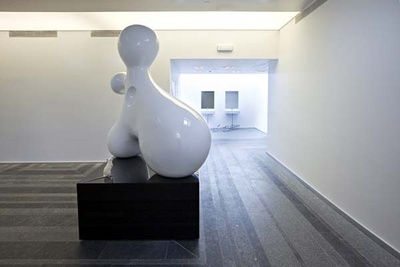
Elmgreen & Dragset: 'Perception II' (2010) © the artists; Courtesy PinchukArtCentre; Photo by Markus Tretter
In one room, they showed two sculptures in dialogue with eath other: On one side, there was an oversized rocking chair in dimensions for an adult person. On the other side, there was an abstract sculpture ('Perception II'), painted in the same glossy white as the rocking chair. A stuffed white rat was staring up in admiration at the sculpture's cury shape. For Michael Elmgreen, this referes to 'the spectator as voyeur.'
I was especially interested in the positions, women took within this show:
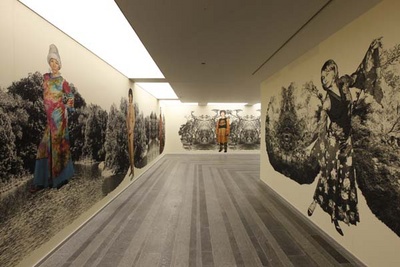
Cindy Sherman: 'Untitled', 2010; © by the artist; Courtesy PinchukArtCentre; Photo by Markus Tretter
Cindy Sherman did a number of prints on the walls with women in strange traditional dresses in front of black and white untouched nature. These women seem to be representing and questioning their female role model at the same time.
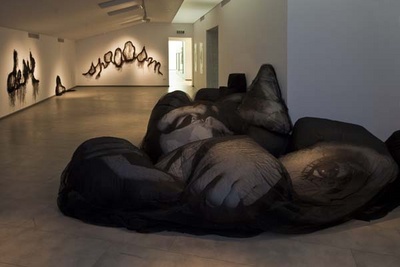
I liked Annette Messager’s contribution to the show: For ‘A Corps Perdu’, the French artist uses objects with enlarged body photographs and mysteriously hides them with tulle veils. She says. ‘For me tulle is like a protective layer.’ In contrary to this fragile work, there are the crude wall objects: ‘Desir ‘(2009), ‘Sexe couche (Resting sex)’ (2010), ‘Spaaasm’ (2010). I think Ms. Messager’s work is very strong without being trapped into overused female clichés.
The Russian group of artists, AES+F, continued their project ‘The Feast of Trimalchio’: It is an episode taken from the Latin novel ‘Satyricon’. Set in every day’s life of ancient Rome, Trimalchio is an ex-slave, who became a rich freedman. In a certain passage of the book, he shows his wealth off by an eccentric new money dinner party.
AES+F transferred this feast to the third millennium: Their typical clean and over-aestheticized figures are ‘masters’ and ‘servants’ of a surreal luxury hotel setting. In the end the ‘masters’ serve the ‘servants’.
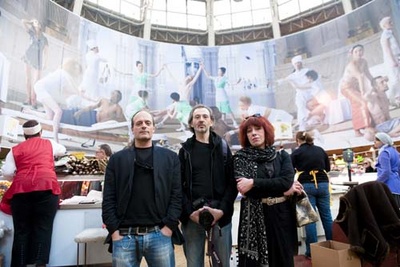
Installation view with the artists: Lev Evzovich, Vladimir Fridkes and Tatyana Arzamasova (AES+F artist group); Photographs provided by the PinchukArtCentre. © 2010 Photographed by Sergei Illin
The artists say ‘Thanks to Petronius' fantasy, Trimalchio's name became synonymous with wealth and luxury, with gluttony and with unbridled pleasure in contrast to the brevity of human existence.’ It perfectly suits their concept to install this frieze of 80 meters / 263 ft. in the Bessarabskiy market hall (opposite Pinchuk Art Centre) where regular people buy their groceries.
So, whatever inflation might do to our currencies, Kiev is always a cool party.